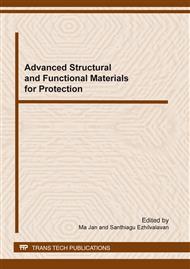p.31
p.34
p.37
p.44
p.48
p.51
p.55
p.60
p.65
On the Design of Bi-Layer Armor Materials
Abstract:
A modified Florence model to predict ballistic limit velocity (BLV) for bi-layer armor systems comprising ceramic front and metallic backing plate is proposed based on energy conservation. Maximization of the BLV for a given AD or TT is studied. Comparison between the maximum BLV obtained from new model, two other available models in the literature and experiments is performed. It is shown that the new model, Energy model compares well to the experimental data. Keywords: Impact; perforation; optimization; bi-layer armor system
Info:
Periodical:
Pages:
48-50
Citation:
Online since:
February 2012
Authors:
Keywords:
Price:
Сopyright:
© 2012 Trans Tech Publications Ltd. All Rights Reserved
Share:
Citation:


